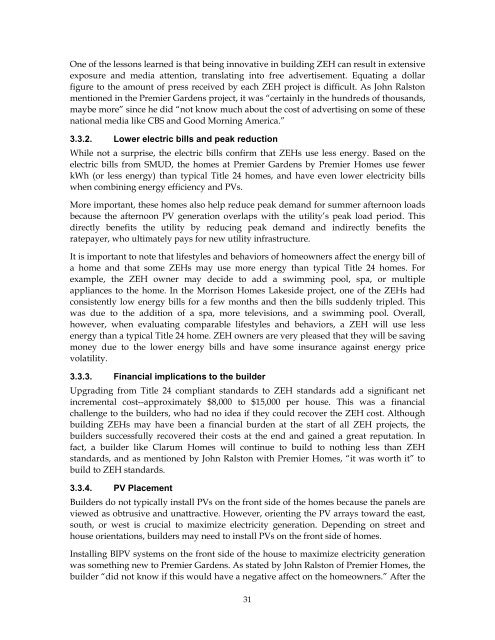design process study for the demonstration homes - Architectural ...
design process study for the demonstration homes - Architectural ...
design process study for the demonstration homes - Architectural ...
Create successful ePaper yourself
Turn your PDF publications into a flip-book with our unique Google optimized e-Paper software.
One of <strong>the</strong> lessons learned is that being innovative in building ZEH can result in extensive<br />
exposure and media attention, translating into free advertisement. Equating a dollar<br />
figure to <strong>the</strong> amount of press received by each ZEH project is difficult. As John Ralston<br />
mentioned in <strong>the</strong> Premier Gardens project, it was “certainly in <strong>the</strong> hundreds of thousands,<br />
maybe more” since he did “not know much about <strong>the</strong> cost of advertising on some of <strong>the</strong>se<br />
national media like CBS and Good Morning America.”<br />
3.3.2. Lower electric bills and peak reduction<br />
While not a surprise, <strong>the</strong> electric bills confirm that ZEHs use less energy. Based on <strong>the</strong><br />
electric bills from SMUD, <strong>the</strong> <strong>homes</strong> at Premier Gardens by Premier Homes use fewer<br />
kWh (or less energy) than typical Title 24 <strong>homes</strong>, and have even lower electricity bills<br />
when combining energy efficiency and PVs.<br />
More important, <strong>the</strong>se <strong>homes</strong> also help reduce peak demand <strong>for</strong> summer afternoon loads<br />
because <strong>the</strong> afternoon PV generation overlaps with <strong>the</strong> utility’s peak load period. This<br />
directly benefits <strong>the</strong> utility by reducing peak demand and indirectly benefits <strong>the</strong><br />
ratepayer, who ultimately pays <strong>for</strong> new utility infrastructure.<br />
It is important to note that lifestyles and behaviors of homeowners affect <strong>the</strong> energy bill of<br />
a home and that some ZEHs may use more energy than typical Title 24 <strong>homes</strong>. For<br />
example, <strong>the</strong> ZEH owner may decide to add a swimming pool, spa, or multiple<br />
appliances to <strong>the</strong> home. In <strong>the</strong> Morrison Homes Lakeside project, one of <strong>the</strong> ZEHs had<br />
consistently low energy bills <strong>for</strong> a few months and <strong>the</strong>n <strong>the</strong> bills suddenly tripled. This<br />
was due to <strong>the</strong> addition of a spa, more televisions, and a swimming pool. Overall,<br />
however, when evaluating comparable lifestyles and behaviors, a ZEH will use less<br />
energy than a typical Title 24 home. ZEH owners are very pleased that <strong>the</strong>y will be saving<br />
money due to <strong>the</strong> lower energy bills and have some insurance against energy price<br />
volatility.<br />
3.3.3. Financial implications to <strong>the</strong> builder<br />
Upgrading from Title 24 compliant standards to ZEH standards add a significant net<br />
incremental cost--approximately $8,000 to $15,000 per house. This was a financial<br />
challenge to <strong>the</strong> builders, who had no idea if <strong>the</strong>y could recover <strong>the</strong> ZEH cost. Although<br />
building ZEHs may have been a financial burden at <strong>the</strong> start of all ZEH projects, <strong>the</strong><br />
builders successfully recovered <strong>the</strong>ir costs at <strong>the</strong> end and gained a great reputation. In<br />
fact, a builder like Clarum Homes will continue to build to nothing less than ZEH<br />
standards, and as mentioned by John Ralston with Premier Homes, “it was worth it” to<br />
build to ZEH standards.<br />
3.3.4. PV Placement<br />
Builders do not typically install PVs on <strong>the</strong> front side of <strong>the</strong> <strong>homes</strong> because <strong>the</strong> panels are<br />
viewed as obtrusive and unattractive. However, orienting <strong>the</strong> PV arrays toward <strong>the</strong> east,<br />
south, or west is crucial to maximize electricity generation. Depending on street and<br />
house orientations, builders may need to install PVs on <strong>the</strong> front side of <strong>homes</strong>.<br />
Installing BIPV systems on <strong>the</strong> front side of <strong>the</strong> house to maximize electricity generation<br />
was something new to Premier Gardens. As stated by John Ralston of Premier Homes, <strong>the</strong><br />
builder “did not know if this would have a negative affect on <strong>the</strong> homeowners.” After <strong>the</strong><br />
31








